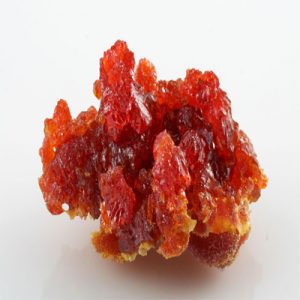Zincite
Zincite is an amazingly beautiful and very rare gem with intense colors of red, orange, yellow and rarely green. The chemical formula of Zincite is (Zn,Mn2+)O (Zinc Manganese Oxide) and its molecular weight is 80.34 gm. Its refractive index is close to a diamond’s (2.417) and therefore has lots of fire. Gem quality Zincite crystals have been found in only a few locations in the world. The most notable is the Franklin Mining District, New Jersey. Gems from this location are extremely rare and usually dark red, colored mostly by the iron and manganese content, and associated with Franklinite and Willemite.
Another source of Zincite gems is a smelter at a Zinc mine at Breslau, Silesia, Poland. Zincite crystals were formed accidentally as the result of a chimney fire in a smelter at the Zinc mine. Zincite has a specific gravity of 5.64 – 5.68 (g/cm3) and the refractive index of 2.013 – 2.029 Uniaxial ( + ). These crystals are not considered synthetic since they weren’t grown in a laboratory environment but are not a natural crystal. These crystals have been used to cut some of the brightest and most highly refractive gems with superb colors ranging from deep red to deep green including bright orange, lemon yellow and bright green. Synthetic Zincite gems are also available on the gem market. Synthetic crystals can be colorless, yellow, light green, orange and dark red.
Distribution: In the USA, from Franklin and Sterling Hill, Ogdensburg, Sussex County, New Jersey; in the Tonopah-Belmont mine, Osborne district, Maricopa County, Arizona, the result of a mine fire; in volcanic ash from Mt. St. Helens, Skamania County, Washington. At Tsumeb, Namibia. From Kipushi, 28 km southwest of Lubumbashi, Katanga Province, Congo (Shaba Province, Zaire). Other localities have been reported but lack supporting data or an accurate location.
| Category: | Oxide mineral |
| Chemical Formula: | (Zn,Mn2+)O |
| Zinc Manganese Oxide | |
| Molecular Weight: | 80.34 gm |
| Composition: | Manganese | 6.84 % | Mn | 8.83 % | MnO |
| Zinc | 73.25 % | Zn | 91.17 % | ZnO | |
| Oxygen | 19.91 % | O | |||
| 100.00 % | 100.00 % | = TOTAL OXIDE |
| Crystallography: | Hexagonal – Dihexagonal Pyramidal |
| Crystal Habit: | Crystals rare, typically pyramidal, hemimorphic, with large {0001}, to 2.5 cm, rarely curved; in broad cleavages, foliated, granular, compact, massive. |
| Twinning: | On {0001}, with composition plane {0001} |
| Cleavage: | Perfect on {1010}; parting on {0001}, commonly distinct |
| Fracture: | Conchoidal |
| Tenacity: | Brittle |
| Moh’s Hardness: | 4.0 |
| Density: | 5.64 – 5.68 (g/cm3) |
| Luminescence: | Usually none in medium to darker colored specimens; rarely yellow fluorescence under LW UV from lighter colored specimens. Only light yellow material from Sterling Mine may fluoresce yellow-green under SW UV. |
| Radioactivity: | Not Radioactive |
| Color: | Light to dark Yellow, Yellow-Orange, Orange, deep Red, rarely Green |
| Transparency: | Transparent, Translucent, Opaque |
| Luster: | Sub-adamantine to Resinous |
| Refractive Index: | 2.013 – 2.029 Uniaxial ( + ) |
| Birefringence: | 0.0160 |
| Dispersion: | 0.127 |
| Pleochroism: | None |
| Anisotrophism: | Weak; color in reflected light: light rose brown |


